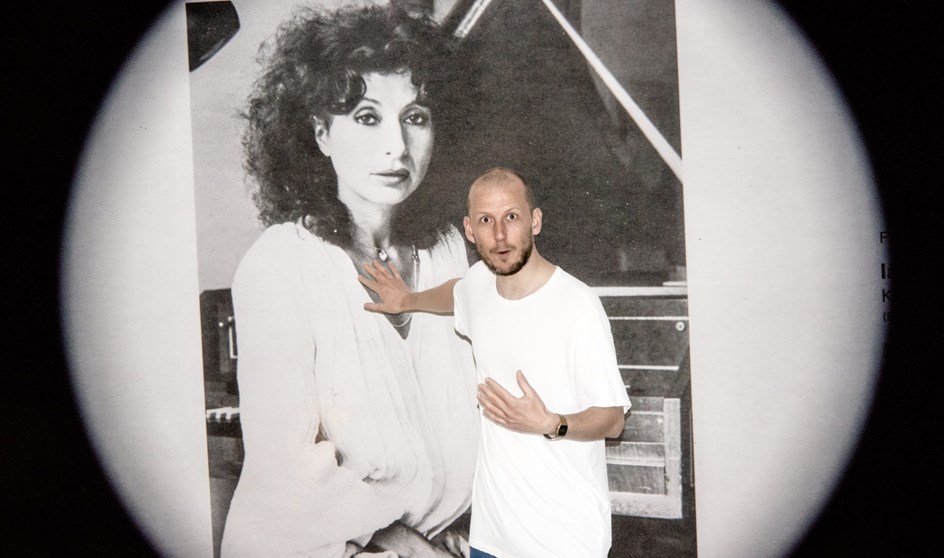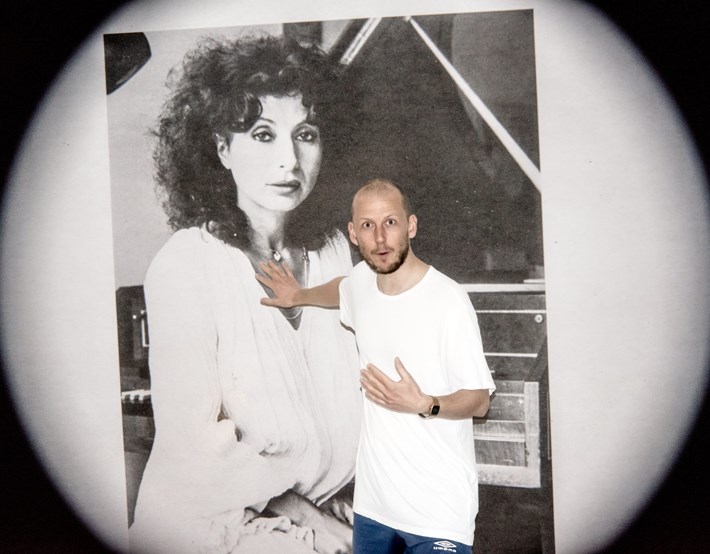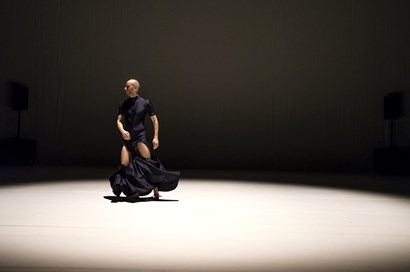
Interview: Jan Martens wants to make the unloved beloved

It may be the last time he has handled his body so ‘violently’. It is physically challenging: dancing choreographies based on virtuoso harpsichord performances by harpsichordist Elisabeth Chojnacka. Jan Martens regarded it as a challenge and an opportunity to give Chojnacka the spotlight she deserves in the solo ELISABETH GETS HER WAY. 'I want to make the unknown and unloved known and beloved.'
The clock strikes 9am in Rotterdam, but in Taipei it’s 4pm. Jan Martens appears in a tank top on Zoom for a conversation about ELISABETH GETS HER WAY. The Flemish choreographer and dancer is in Taiwan's capital for three performances of any attempt will end in crushed bodies and shattered bones, a grand production with dancers aged 15 to 72. Very different from his solo ELISABETH GETS HER WAY, in which he dances himself. On Saturday 18 November, he will perform the solo at Korzo, paying tribute to the relatively unknown Polish harpsichordist Elisabeth Chojnacka, who became known for her dynamic playing and live performances.
Hi Jan! How did you get into harpsichord music? Not the most common instrument.
'That came about quite by chance. I wanted to work with protest music for any attempt, but not with too obvious names like Nina Simone or Bob Dylan. I ended up using a composition for strings and harpsichords by Henryck Górecki, a Polish composer who was inspired by American minimalism at the time of protests against the communist government in Poland.'
'Only during the creation of that work I saw a video recording of the premiere of the piece in 1980. The woman behind the harpsichord blew me away with her strong charisma and vicious and precise playing. I also read in the score that it was written especially for her. That prompted me to find out more about her. Little by little, I found more intriguing music and information, so much so that I decided to make a production about her and her life.'
I often hear dancers and choreographers talk about research. Can you tell me more about your research phase? You hear a lot, see a lot, watch a lot, why did she in particular stand out?
'What I'm still very grateful for: before I knew about Chojnacka, I didn't really have an entry into modern classical music. That was a form of music that never touched me deeply, that didn't speak to me. But through my research I ended up with all kinds of excerpts, for instance where she explains how she plays an extremely complex composition by Xenakis. That made it really insightful for me. She made me listen in a different way, and made something that was previously unfathomable comprehensible. She made me realise the value and beauty of contemporary music. I hope that by adding dance, I can open up her music to an even wider audience.'
'During the research, I came across so many interesting things. For example, I was able to access the library of the Centre Nationale de la Danse in Paris. They hold the complete archive of choreographer Lucinda Childs. The five years Chojnacka played live in Childs' performances suddenly became a lot more insightful through correspondence between the two of them, or video recordings of pieces they created together that cannot be found online.'
I read in other interviews that you recognise in Chojnacka a piece of radicalism that you embody yourself. During the research, did you find many similarities between her and your artistic vision?
Yes, I immediately felt a kind of kinship. Like Chojnacka, I want to make few concessions in my work, but ask the question 'how can I reach an audience with this?' Chojnacka thought a lot about that, in interviews she talks about the importance of clothing and light, and how that can put the audience in the right mood. During baroque pieces she wore a dress, when she played contemporary music she put on trousers and a vest. On and off the stage, she dressed in tiger print, wore a lot of make-up and high heels. She really had a rock attitude. It's great to see old video clips of her, where she played the most radical harpsichord pieces live on prime-time television shows. I find that hugely inspiring.'
'For me, that's often a frustration with dance. Sometimes it seems that dance is either too conceptual, as if it's only made for peers. Or an audience is underestimated, and then dance gives very little food for thought. Like her, I invariably try to find a good balance between the two.'
In translating research into performance, Jan selected seven completely different harpsichord performances by Chojnacka. That’s why you’ll see seven choreographies in ELISABETH GETS HER WAY with different lighting and different costumes. Between the pieces, you’ll get to know Chojnacka through archive footage and interviews.
For you as a dancer, it is a wonderful opportunity to show what you are all about, with seven completely different choreographies.
'Definitely. It's a portrait of Chojnacka, but also a self-portrait. I turn 40 in 2024. I feel this is not the last time I dance, but physically it is a tough solo. I have treated my body violently again for this solo. In two years, I won't be able to do this performance. So for me it was also important to face another challenge, to be even more ambitious and virtuoso in the knowledge that it might be one of the last times.'
You show a lot of archive footage in this performance. Why do you think it's important for people to get to know Chojnacka?
'A common theme in my work is questioning 'what do we know and what don't we know'? What is the canon and why do we know what we know? Why is it that we don't know Elisabeth Chojnacka? It's always a goal for me to make unheard voices resonate.'
'I also hope the audience will ask questions. What are the power structures that keep us from getting to know her? Why is it that sometimes we don't look beyond what is offered to us? For me, that is an important theme in my work, those unheard voices. I bring one out now to demonstrate that, but I’d like to work with even more unheard voices in a future production. Making the unknown and unloved known and beloved is a valuable thing.'
You can see ELISABETH GETS HER WAY by Jan Martens on Saturday 18 November at Korzo. Click here to order tickets.
Check this

Elisabeth Gets Her Way
Dance and music merge in this remarkable ode to harpsichordist Elisabeth Chojnacka
20.15 - 21.15
Korzo Zaal
Check this

New artists in residence for Korzo: Faizah Grootens and Tú Hoàng
If you attended our anniversary programme recently, you’ve already heard the news: Faizah Grootens and Tú Hoàng will become artists in residence for Korzo! Starting in 2025, they get all the time and...
Read more
Ticketsales for India Dance Festival has kicked off!
Programme India Dance Festival announced and ticket sales launched! And we are off! The full programme for India Dance Festival is now online. Eleven days of high-profile performances full of Indian...
Read more